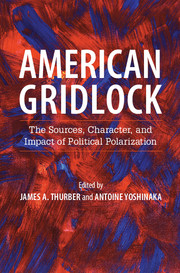Book contents
- Frontmatter
- Dedication
- Contents
- List of contributors
- Foreword
- Acknowledgments
- Introduction
- PART I POLARIZATION AMONG VOTERS AND ACTIVISTS
- PART II POLARIZATION IN NATIONAL INSTITUTIONS
- 6 Presidential-Congressional Relations in an Era of Polarized Parties and a 60-Vote Senate
- 7 Party Warriors: The Ugly Side of Party Polarization in Congress
- 8 The Sources and Consequences of Polarization in the U.S. Supreme Court
- PART III POLARIZATION IN THE STATES
- PART IV POLARIZATION IN THE MEDIA
- PART V IMPLICATIONS AND CONCLUSIONS
- Index
- References
6 - Presidential-Congressional Relations in an Era of Polarized Parties and a 60-Vote Senate
from PART II - POLARIZATION IN NATIONAL INSTITUTIONS
Published online by Cambridge University Press: 05 November 2015
- Frontmatter
- Dedication
- Contents
- List of contributors
- Foreword
- Acknowledgments
- Introduction
- PART I POLARIZATION AMONG VOTERS AND ACTIVISTS
- PART II POLARIZATION IN NATIONAL INSTITUTIONS
- 6 Presidential-Congressional Relations in an Era of Polarized Parties and a 60-Vote Senate
- 7 Party Warriors: The Ugly Side of Party Polarization in Congress
- 8 The Sources and Consequences of Polarization in the U.S. Supreme Court
- PART III POLARIZATION IN THE STATES
- PART IV POLARIZATION IN THE MEDIA
- PART V IMPLICATIONS AND CONCLUSIONS
- Index
- References
Summary
• Party control of Congress is the strongest determinant of presidential success – majority party presidents win more roll call votes than do minority party presidents.
• Until recently, the effects of party control were similar in both chambers. Rising party polarization in Congress affects presidential success differently in the House and Senate.
• In the House, party polarization amplifies the effects of party control – as party polarization increases, majority party presidents win more and minority presidents win less.
• In the Senate, party polarization suppresses success rates – majority presidents still win more on average, but as party voting increases, success rates decline for both majority and minority presidents.
• The rise in cloture votes and the emergence of the minority party filibuster during the Bush and Obama presidencies is responsible for the changes in how party polarization conditions the effects of party control in the Senate.
• Since cloture votes are unique to the Senate, excluding cloture votes provides a mix of Senate votes similar to the House – as party polarization increases on non-cloture votes, majority presidents win more and minority presidents win less, though the relationships are weaker than in the House.
• On cloture votes, polarization magnifies the effects of party control, but the pattern of success is a mirror image of the House – as party polarization increases, minority presidents win more and majority presidents win less.
• The simple arithmetic of which side of cloture the president is on explains why the relationships flip. Majority presidents usually favor invoking cloture, which requires 60 votes to win. Minority presidents usually oppose invoking cloture, which requires only 41 votes to win.
To achieve his goals, the president must persuade Congress to support his positions. Ite's a hard sell. The American system of “separated institutions sharing powers” (Neustadt 1960: 33) makes it difficult for any president to win support from Congress. Presidential success in Congress varies – some presidents win more than others – but President Obama seems to be having an especially hard time. In 2012, for example, Obama won only 15.5 percent of House roll call votes on which he expressed a position. Thate's pretty low, but not quite a record – President Bush barely holds on to this dubious distinction, winning only 15.4 percent of House roll calls in 2008.
- Type
- Chapter
- Information
- American GridlockThe Sources, Character, and Impact of Political Polarization, pp. 133 - 151Publisher: Cambridge University PressPrint publication year: 2015
References
- 6
- Cited by



